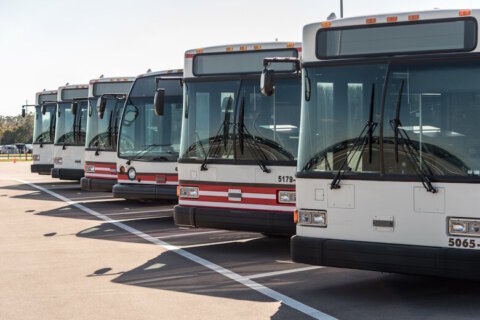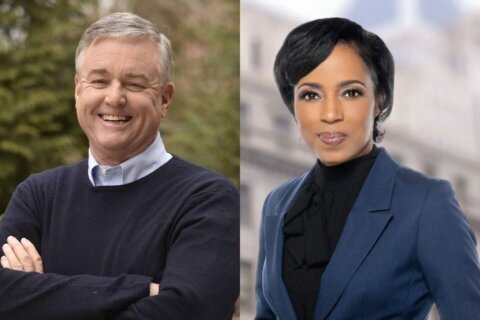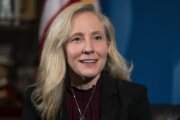Maryland voters set the stage Tuesday for this fall’s election.
It follows months of campaigning, a delay over a redistricting court fight, and the mailing of hundreds of thousands of mail-in ballots.
And with in-person voting over, it marks the beginning of what’s expected to be a long wait for the final results.
In Prince George’s County, voter Kadesha Powell Sadiq said the issues motivating her vote were education, women’s health and crime. She backed Wes Moore to be the Democratic nominee for governor, saying he would be a “great and fair leader.”
Another voter, George, backed Moore as well.
“The better the kids are educated, the more they can succeed in life. And that’s one of the reasons that I’m voting for him, because he spoke so firmly about education,” he said.
Another voter named Gene said he was a Republican but voting in the Democratic primary so he could vote for “sane people.”
“I’m pretty much a centrist,” he said.
Education was foremost on his mind, with so many schoolkids behind on their studies due to the pandemic.
“There’s going to be a lot of things that need to be done, and we’re barely starting on it,” he said.
Voters weighed in on a number of key races, including governor.
A crowded field of candidates on the Democratic side features nine candidates. Polling leading up to primary day indicated the race had tightened to a three-man race among bestselling author Wes Moore; Tom Perez, the former head of the Democratic Party; and the longtime Maryland comptroller Peter Franchot.
Other Democratic candidates include former U.S. Education Secretary John King; former Maryland Attorney General Doug Gansler; former Obama White House staffer Ashwani Jain; former Clinton administration official Jon Baron; retired teacher Ralph Jaffe and philosopher and perennial candidate Jerome Segal.
On the Republican side, the race has pitted former Commerce Secretary Kelly Schulz, who is backed by Hogan, against challenger Del. Dan Cox, who has been endorsed by former President Donald Trump.
Former Del. Robin Ficker, an anti-tax advocate, is also seeking the Republican nomination, as is attorney Joe Werner.
With Gov. Larry Hogan on the way out after finishing his second term, some voters are welcoming the incoming change in leadership.
“We don’t want anybody in place for too long,” said one woman in Montgomery County. “That’s where you don’t get that change. … You don’t get that innovation.”
Still, others aren’t so excited that Hogan’s reached his two-term limit.
“I am hoping that whomever comes in can kind of either carry the mantle forward and do well as he did or whomever comes in doesn’t disrupt things too greatly,” another voter said.
In addition, voters are picking nominees for Maryland attorney general and comptroller, which acts as the state’s tax collector.
There are several other primary races on the ballot. U.S. Sen. Chris Van Hollen, who is running for a second term, is facing a primary challenge. All eight of Maryland’s U.S. House seats are on the ballot. There is one open House seat in the 4th District, which includes Prince George’s County, with incumbent Rep. Anthony Brown making a bid for Maryland attorney general.
In addition, there are a slew of local races on the ballot, including closely watched county executive and council races in Montgomery and Prince George’s counties.
When can you expect results?
Expect the vote-counting to take much longer than a typical primary.
Maryland election officials cannot start counting mail-in ballots until Thursday at 10 a.m. That means only in-person voting tallies will be reported Tuesday evening — and it’s possible, given the large number of mail-in ballots, that the outcome of several races won’t be known for several days or even weeks.
The Maryland General Assembly approved legislation this spring that would have allowed local boards of elections to count mail-in ballots early. But Hogan vetoed the measure, saying it lacked election security measures.
As of Monday, state election officials had sent out nearly 500,000 mail-in ballots to voters and had received back more than 213,000. The number of mail-in ballots received is expected to climb since voters have until 8 p.m. Tuesday to drop their ballots in a drop box, and ballots that are mailed could take even longer to arrive at the board of elections.
That compares with only about 30,000 mail-in ballots in the 2018 primary.
One Marylander told WTOP’s Neal Augenstein that he wants to see improvements to get votes tallied faster and with more accuracy, but that he doesn’t mind waiting in the meantime.
“It’s 2022 and we all wonder why we can’t have immediate information, because that’s what we’re accustomed to,” he said. “But at the same time, we want clean and accurate results.”
Another voter at the polls echoed a similar sentiment.
“I will probably go to sleep without knowing who it is and I am definitely OK with that,” she said.
How voting compares with 2018
The number of voters casting ballots in person during early voting this year was a bit lower than four years ago. Overall, about 172,000 Marylanders voted during the week of in-person early voting, compared with about 220,000 who voted early in the 2018 primary.
Still, the large number of mail-in ballots has pushed the total number of ballots cast ahead of primary day above the early totals in 2018. If you combine early voting with mail-in ballots received, a total of more than 385,000 ballots have been cast this year. That compares with about 252,000 total early votes and mail-in ballots cast in 2018.
Overall, a total of 872,207 Marylanders cast ballots in the 2018 primary, which was the largest raw vote count in a primary in the state’s history.
Maryland’s primary was pushed back from its original date in late June as the result of a court decision amid legal challenges to a contentious redistricting fight. A redrawn map of House districts approved by the Democratic-controlled General Assembly was thrown out after a gerrymandering lawsuit.
The general election is Nov. 8.
WTOP’s Jessica Kronzer contributed to this report.








